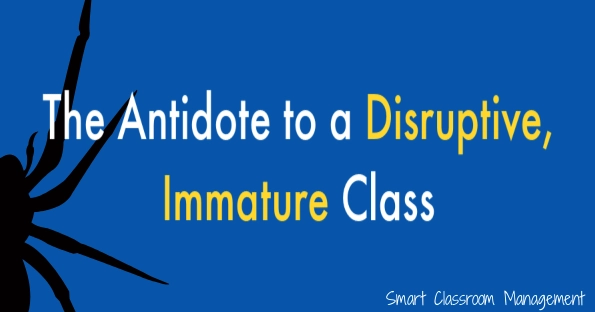The Antidote To A Disruptive, Immature Class


I’m often asked what to do when your class isn’t badly behaved, but still disruptive.
In other words, as a group they tend to be excitable and talkative. Every transition and activity you have to settle and quiet them down.
It’s a common question because it causes so much teacher stress.
After perusing the SCM website, many teachers decide that they need to be more consistent following their classroom management plan.
This is important, to be sure.
Being consistent is non-negotiable for good classroom management. It’s an essential step, as is bringing your own calm presence to the classroom. Together, they make a huge difference.
However, all-class misbehavior can often be traced back to sloppy routines. The standards of which are almost always too low and ill defined.
Everything you do repeatedly as a class, like entering the classroom, transitioning from one activity to the next, or opening laptops, should be made into a highly specific routine students do without your input.
Well-taught routines are critical because they:
Keep students focused.
Provide sustained purpose.
Save weeks of learning time.
Reduce your need to talk.
Lower your stress level.
Place more responsibility on students’ shoulders.
Cut way down on misbehavior.
Make everything easier.
The totality of the effect on students is that they become more mature.
Having objectives to accomplish, with little let up, removes silliness, distractability, and dependency on the teacher. The more routines you have, the better.
So if this is you, if you’re stressed and overworked and feel as if you have to do everything for your students, including talking them through every this and that, then you must teach—or reteach—highly detailed routines.
Show your students precisely how to sit quietly and work, ask a question, line up for lunch, hang up their backpack, gather into groups, give their attention, etc. Model what it looks like. Have your class practice until they can prove to you they can do it perfectly.
Then hold them to it every moment of every day.
And whenever they don’t mirror back the high standard you’ve set, then have them repeat the routine. Accept nothing less than excellence, and that’s what you’ll get.
The best part about requiring perfect routines is that it transfers to everything you do. I once had a teacher think I was silly to put so much emphasis and detail in the routines I required.
But what this teacher didn’t realize was that I was setting an example for how to approach math, science, writing, and every other academic subject. I was infusing the discipline and work habits that result in true academic progress.
I was also preparing them for life outside of the school system.
The truth is that you should go overboard in teaching routines. You should be a NASA engineer preparing the Saturn V for a trip to the moon. Details can spell the difference between Apollo 1 and Apollo 11.
Now, while it’s true that the older your students are the less you have to model routines, this doesn’t mean that your routines should be any less specific. Also, routines don’t have to be militaristic.
They can look as relaxed as you wish as long as that is the expectation. For years, I had my students walking to lunch in a quiet herd around me—no line whatsoever.
I’ve also added various dances, movements, and unrelated tasks to make my routines multi-step, memorable, and more challenging, allowing me to continually ask more of my students.
Having a well-behaved class is about your leadership. It’s about boldly teaching and raising expectations, even amid the reversing tides of the culture and low standards infecting our schools.
There is a lot to this topic, but we’ve got you covered. From how to teach routines to how to hold students accountable can be found in the Procedures & Routines category of the archive.
I encourage you to read, learn, and then double down on routines starting ASAP. In a week, you’ll have a different class.
PS – My new book Inspire, which describes the principles you need to carry with you every day in order to transform student behavior and learning, is now available.
Also, if you haven’t done so already, please join us. It’s free! Click here and begin receiving classroom management articles like this one in your email box every week.

